Work has been very busy the last few months, and I normally don’t get a full day off. Managing call centers is a 7 day a week gig. I am not complaining, I have a job, and work for a great guy, but I needed a day off.
Friday, a few weeks ago, I took a day… An almost real day off. I turned the phone off, only checking it a couple of times, and let my staff do the work. I decided to take the old Goldwing and put it on the highway for a day trip. Leathers, boots, Nikon d7000, and a full tank of gas… That is the airplane equivalent of ‘wheels up, flaps up, on course.’ I don’t say much about riding the bike because it is such a divided issue. For those that do ride, you know how often we hear a stranger walk up and start conversations like… “well, I used to ride till one by one all of my family got killed on one of them things…”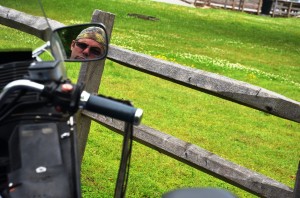
“Well, thanks for that information.”
I think it is sometimes like being a pregnant women… some folks just feel obligated to reach out, touch your belly, and share the good, the bad, the ugly… as if that is any of their business. Oh well… to be human. 🙂
I digress. Anyway, if you don’t ride there isn’t much to say, but if you do, then you will get this. There is nothing like riding a motorcycle. If it is for you, then it is. If it isn’t… then don’t do it.
When I was a kid, Grease came out in 1978 and flooded us with music and stories, and for me already loving anything with an engine, it sparked a passion for bikes that has carried on since then. Also, Honda introduced the Honda the CB750, back in 1968 (I believe). By 1978 they had fitted one out with a fairing and saddle bags, and it was a dream come true. I would sit and listen, it seems for hours, to “Greased Lightning’ while dreaming of shifting through the gears, leaning into turns, and just being a ‘tough biker dude’.
That dream didn’t really happen for years. I spent my 20’s, 30’s, and early 40’s being a ‘non biker dude’, and then, only 5 years ago or so, the bike dream came to fruition. It was a 1983 Honda Goldwing. Not exactly a ‘starter’ bike, since it is a 1100 cc’s and heavy. But I fell in love right away. I did a fair amount of ‘test’ riding in fields, and started working my way up to roads, and eventually small trips with other riders.
Since then I’ve been from the “Dragon” on the Blue Ridge Parkway, Highway 12 in Ocracoke, to Corolla NC, Lambskin road in Virginia, down to Fishy Fishy seafood restaurant in Southport NC and just about anywhere else I have the time and space to ride. But a few weeks ago I took my first bike ride of the season, and headed east to Plymouth, and Bath NC.
There is a true exhilaration to twisting a throttle and feeling the bike want to stand up in a turn. As the pavement rolls underneath you, the sky and and trees flash past, you are connected with your surroundings more intimately than if you are in car. Everything feels alive, and for me that day, as I merged out on 64 to go west, the rpm’s were up, the bike was pulling down the road and the paint lines started to blur.
There is a skill level that goes with managing a bike. It isn’t as much about balance to me as it is about thinking ahead, and thinking for others. ‘Paranoia’ is a good word! I am on a bigger bike, so it isn’t as easy to miss seeing me, but as a biker, you have to think for yourself and for those around you. For me, I ALWAYS assumed they don’t know I am there… and I keep up with where everyone is, and make sure I have plenty of exist plans. Also, 18 wheelers and I give each other a wide birth.
Once I get into my routine it is ‘lock the throttle’ and roll down the super-slab. I can roll about a 100 to 150 miles before needing to stretch. Changes in pavement are always fun, and then there is weather. Rain, of course, is totally different on a bike than in a car.
All that being said, my early morning departure means the highways are quiet and it’s me and the whine of the drive shaft going down the road.
My first stop is Plymouth N.C. 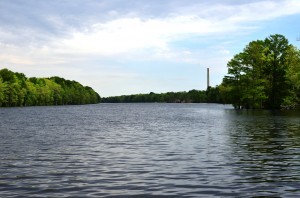 The town was held by the South for a while during the ‘recent incivilities’, taken by the North, then back by the South and eventually won by the North. It is home to one of the most interesting Civil War River battles.
The town was held by the South for a while during the ‘recent incivilities’, taken by the North, then back by the South and eventually won by the North. It is home to one of the most interesting Civil War River battles.
“In a combined operation with the ironclad ram CSS Albemarle, Confederate forces under Maj. Gen. Robert F. Hoke, attacked the Federal garrison at Plymouth, North Carolina, on April 17. On April 19, the ram appeared in the river, sinking the USS Southfield, damaging the USS Miami, and driving off the other Union Navy ships supporting the Plymouth garrison.
Confederate forces captured Fort Comfort, driving defenders into Fort Williams. On April 20, the garrison surrendered.”
And
“Albemarle successfully dominated the Roanoke and the approaches to Plymouth through the summer of 1864. By autumn the U. S. government decided that the situation should be studied to determine if something could be done: The U. S. Navy considered various ways to destroy Albemarle, including two plans submitted by Lieutenant William B. Cushing; they finally
approved one of his plans, authorizing him to locate two small steam launches that might be fitted with spar torpedoes. Cushing discovered two 30-foot (9.1 m) picket boats under construction in New York and acquired them for his mission (some accounts have them as 45 feet (14 m) to 47-feet). On each he mounted a Dahlgren 12 pounder howitzer and a 14-foot (4.3 m) spar projecting into the water from its bow. One of the boats was lost at sea during the voyage from New York to Norfolk, Virginia, but the other arrived safely with its crew of seven officers and men at the mouth of the Roanoke. There, the steam launch’s spar was fitted with a lanyard-detonated torpedo.
On the night of October 27 and 28, 1864, Cushing and his team began working their way upriver. A small cutter accompanied them, its crew having the task of preventing interference by the Confederate sentries stationed on a schooner anchored to the wreck of Southfield; both boats, under the cover of darkness, slipped past the schooner undetected. So Cushing decided to use all twenty-two of his men and the element of surprise to capture Albemarle.
As they approached the Confederate docks their luck turned, and they were spotted in the dark. They came under heavy rifle and pistol fire from both the shore and aboard Albemarle. As they closed with the ironclad, they quickly discovered she was defended against approach by floating log booms. The logs, however, had been in the water for many months and were covered with heavy slime. The steam launch rode up and then over them without difficulty; with her spar fully against the ironclad’s hull, Cushing stood up in the bow and pulled the lanyard, detonating the torpedo’s explosive charge.
The explosion threw Cushing and his men overboard into the water; Cushing then stripped off most of his uniform and swam to shore, where he hid undercover until daylight, avoiding the hastily organized Confederate search parties. The next afternoon, he was finally able to steal a small skiff and began slowly paddling, using his hands and arms as oars, down-river to rejoin Union forces at the river’s mouth. Cushing’s long journey was quite perilous and he was nearly captured and almost drowned before finally reaching safety, totally exhausted by his ordeal; he was hailed a national hero of the Union cause for his daring exploits.
Of the other men in Cushing’s launch, one also escaped, two were drowned following to the explosion, and the rest were captured. Cushing’s daring commando raid blew a hole in Albemarle’s hull at the waterline “big enough to drive a wagon in.” She sank immediately in the six feet of water below her keel, settling into the heavy river bottom mud, leaving the upper casemate mostly dry and the ship’s large Stainless Banner ensign flying from the flagstaff at the rear of the casemate’s upper deck.
Confederate commander Alexander F. Warley, who had been appointed as her captain about a month earlier, later salvaged both of Albemarle’s rifled cannon and shells and used them to defend Plymouth against subsequent Union attack—futilely, as it turned out.”
When you pull into Plymouth you can see, down by the river front, that there is a revitalization of the Main Street that runs parallel to the water. In true Southern fashion, we have a floating replica of the C.S.S Albemarle that once a year makes a cannon popping re-enactment of the war days on the riverfront. 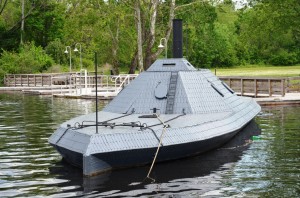 (see http://www.livinghistoryweekend.com/) I often wonder, as I sit at the docks where the battle took place, what life in Plymouth was like 150 years ago. I think we all would be grateful we live in this generation.
(see http://www.livinghistoryweekend.com/) I often wonder, as I sit at the docks where the battle took place, what life in Plymouth was like 150 years ago. I think we all would be grateful we live in this generation.
Then it is off to Bath, NC. This is one of Elizabeth and my favorite places to visit. It is actually the oldest town in NC and true to NC lore, this was the one time home of Blackbeard, the Pirate.
“From 1705 until 1722, Bath was the first nominal capital of North Carolina; Edenton was designated next. The colony had no permanent institutions of government until their establishment of the new capital New Bern in 1743.
John Lawson was known as the town father. He documented the beauty and unique qualities of the town, laid out the town plan and helped secure its charter in 1705. On March 8, 1705, the tract of land was incorporated as the town of Bath by the General Assembly at a meeting at Capt. John Heckenfield’s home in Albemarle. Lawson had laid out the town into 71 lots measuring half an acre and four poles (about a tenth of an acre). The lots were located on the waterfront; as was typical, this was the main transportation route. The bordering road is now known as Main Street. Early merchants had easy access by the water.
Blackbeard the pirate was notorious in the southern colonies. He was a prominent figure by the time he settled briefly in Bath. He had conducted piracy off the East Coast and in the West Indies. He settled in Bath in 1718, gaining a royal pardon (these were offered by the Crown through colonial officials in an attempt to reduce piracy). He soon started piracy again, and was captured and executed later that year by Virginia forces.”
By the time I reach the waterfront it’s time to rest. 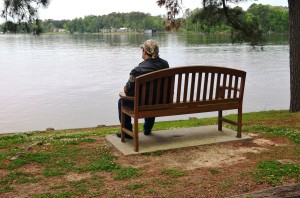 The town has put up benches that overlook the sound and waterway that runs right up to Front Street. It is captivating and doesn’t take long for the hours and miles to catch up with me. I alternate between sitting up looking over the water, to laying flat out, snoring away in the afternoon warmth.
The town has put up benches that overlook the sound and waterway that runs right up to Front Street. It is captivating and doesn’t take long for the hours and miles to catch up with me. I alternate between sitting up looking over the water, to laying flat out, snoring away in the afternoon warmth.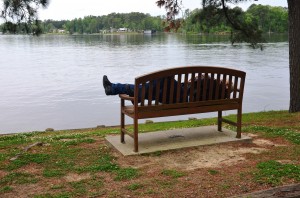
Nice…
Bike rides are something like ‘when you are done you are done’, but you hate to walk away and leave it. I also love the fact, that I can go back, and literally walk the streets of the past, here in my own state and my access is through the wonderful gift of riding a motorcycle.
My ride back contained a bit of rain, some heavy at times, but I eventually drove out of it. By the time I made it back to put the bike in Elizabeth’s garage, it had been a little over 400 miles of highway, waterways, back roads and wonderful sites… a 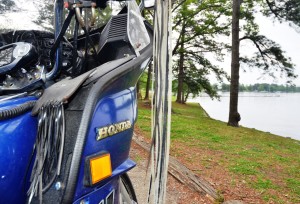 ‘must see and do’ for any motorcyclist.
‘must see and do’ for any motorcyclist.
Safe Travels this week.

